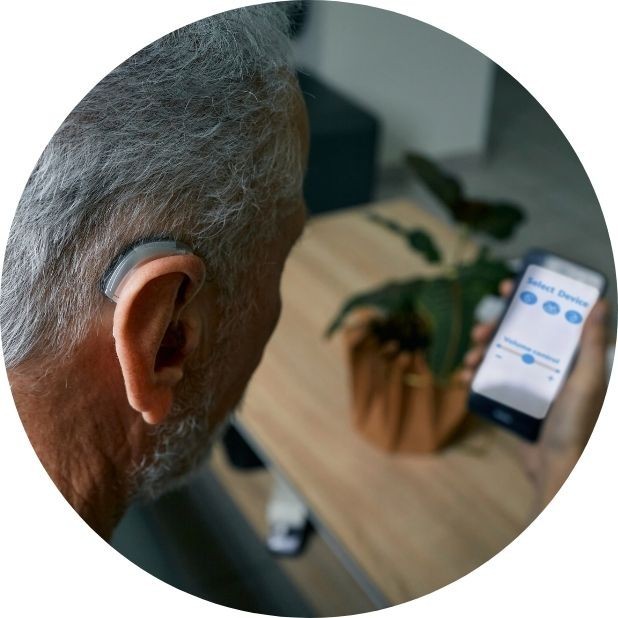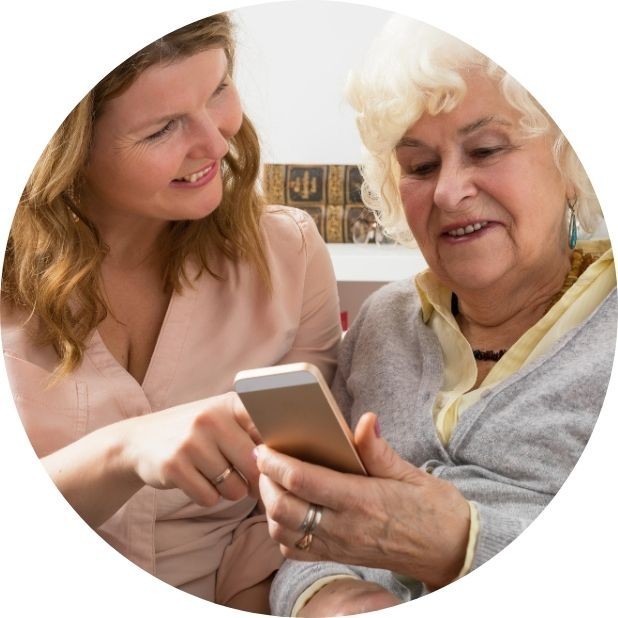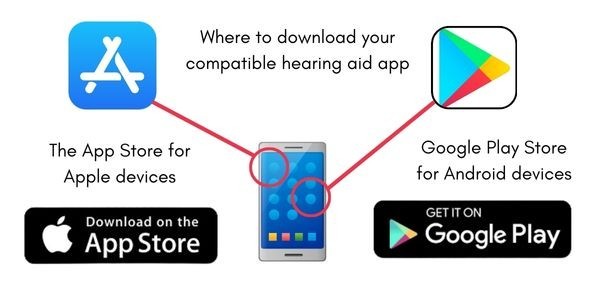
Hearing Aid Apps
Understanding hearing aid apps and their benefits
This is our complete guide to hearing aid apps to help you understand the incredible benefits they offer those wearing hearing aids.
With advancements in technology, hearing aid apps are revolutionising the way those with hearing loss manage their hearing needs.
Here you will find information on the best hearing aid apps, all your FAQs answered, and troubleshooting to help you connect to your Bluetooth hearing aid app.
Find out what hearing aid apps are, what innovative features are available, and how you can benefit from using them.

What is a hearing aid app?
Hearing aid apps explained
Similar to other apps on your smartphone or tablet, hearing aid apps are a type of software that allows you to control your device (phone or tablet) through what’s known as a ‘user interface’, which will be clear and easy to use.
Hearing aid apps' user interfaces are usually designed with older patients in mind, offering an intuitive design for a user-friendly experience. These interfaces allow wearers to interact with their Bluetooth hearing aids, giving more sound options and control.
Hearing aid apps offer a wide range of features to help those with hearing loss by connecting their phone to their hearing aids (also known as device pairing).
Seamless Bluetooth connectivity between your smartphone and hearing aids gives you convenient control and a personalised listening experience.
Note: Bluetooth is a wireless connection but does NOT require WiFi to work, and is denoted on your devices by this symbol:


Do I need a hearing aid app with my hearing aids?
Will my hearing aids work without a hearing aid app?
No, you don’t need an app for your hearing aids to work but they can help you get the best out of your hearing aids.
Unlike older models, hearing aids have become more advanced in adapting to different environments, offering multiple settings to suit a range of situations such as noise reduction and background filtering.
The hearing aid app puts you in control with more options and the ability to choose for yourself on the go. Each person’s hearing loss is unique, allowing adjustments in the app to reflect that.
For example, you may prioritise ‘Speech Clarity’ in a noisy restaurant with a lot of background noise but choose to turn the volume down if it is particularly loud.
Or at home, you might pick a program that has a wider microphone scope for improved sound quality and clarity, which is the better option for watching TV, but you prefer to alter the individual sound frequencies to suit your preferences.

Do hearing aid apps work?
Are Smartphone apps useful for improving your hearing experience?
Hearing aid apps are proven technology
Yes, according to researchers, hearing aid apps have been shown to improve the patient experience by helping them to understand their own hearing loss and support good hearing habits. They can also help the audiologist have a deeper understanding of your hearing loss and the care needed.
This is because hearing aid apps can provide real-world insights during the different stages of a patient’s hearing loss journey, giving the audiologist a better understanding of how they use their hearing aids on a day-to-day basis.
In the context of hearing care, self-management of symptoms through hearing aid apps resulted in an improved relationship and decision-making between the patient and their hearing care provider. The development and use of hearing aid apps have had a hugely positive impact on improving hearing healthcare accessibility and outcomes.
What are the benefits of hearing aid apps?
Make discreet adjustments to suit your hearing needs and protect your hearing aids. As we know, hearing loss management and treatment are usually hearing aids and hearing aid accessories which can significantly improve everyday life by making things easier and more convenient, when facing the challenges hearing loss can bring.
The addition of companion hearing aid apps to other resources can guarantee that patients will see a better quality of life and an improvement in overall well-being.
By making communication and listening easier, whether socially, at work, or with family and friends, wherever you are, hearing aid apps put the control at your fingertips.
Hearing aid apps support those with dexterity issues
Having the app at your fingertips, whether on your phone or tablet, is easy and convenient, especially if you struggle with small switches or fiddly controls on hearing aids that are, without question, becoming increasingly smaller as the technology evolves.
Hearing aid apps essentially allow you to use your phone as a remote control, which is also more discreet than touching your ears in public. This is ideal as some wearers would rather not draw attention to their hearing aids.
Not touching your hearing aids so much throughout the day can also protect them from accumulating dirt and accidental damage. You can wear your hearing aids with confidence and safely get the best experience from them by adjusting them from your phone.

The Advantages of Using Hearing Aid Apps
What helpful features and functions are available in hearing aid apps?
Hearing aid apps and their uses
Patients often ask, ‘What can hearing aid apps be used for?’ but a better question might be what they can’t! Here we provide a list of popular hearing aid apps and features you might benefit from.
It is important to remember that all hearing aids and apps will differ. This is a list of features generally available on manufacturers’ companion apps but if there is a specific function you would like to use, speak to your audiologist for the best hearing aid type for you.
What can your hearing aid app do?
Adjust hearing aid volume: On the hearing aid app, you will see volume controls that refer to each hearing aid. If you have hearing aids for both ears you can increase or decrease the volume to suit your situation, with controls for left and right working independently.
It is possible to alter frequencies to suit your needs, whether it’s bass, mid, or high tones that you struggle with.
Track your battery power: This is especially helpful when out and about or when you’ve been streaming a lot, as this can use up a lot of power. Now there is no need to get caught out with flat hearing aid batteries or run out of charge in rechargeable models.
Stream your phone calls: Direct Bluetooth streaming is one of the most useful features digital hearing aids can offer. When connected via Bluetooth, your phone calls can be streamed directly into your ear.
With some devices, tap control is available, which means you don’t even have to touch the phone; you simply tap on your ear to answer. It’s easy and convenient.
Remote adjustments by your audiologist and telehealth: Distance monitoring allows audiologists to manage their patients’ hearing loss symptoms remotely. You can provide feedback to your audiologist, and they can adjust your hearing aids to your preferences, fine-tuning them from their office.
Both convenient and ideal for those who struggle to leave their home, and it can also cut down on transport costs and travel time, ideal when combined with our free home visit services.
Stream entertainment from your devices: Integration with Bluetooth and wireless devices now means you can easily listen to your media on the go. Whether it’s listening to audiobooks and music or watching videos on YouTube or Netflix, the possibilities are endless.
If you use the platform on your phone or tablet, the sound can be streamed directly into your ears for an easier and clearer listening experience.
Switch between preset hearing aid programs: Most manufacturers’ apps come with a range of programs already built in so you can select the one that best suits your environment. This could be for background noise in a restaurant or better directionality in a group setting.
Create personalised hearing programs: If you find you select a preset program but always alter a setting or two within it, you can personalise your listening experience by creating your own programs so that they are saved and ready to go with the touch of a button.
Track how long you wear your hearing aids: This is particularly helpful for new hearing aid users. Ideally, a new user will wear their hearing aids for at least 12 hours a day. This is important for getting used to the feel of wearing them and allowing your auditory system to get used to this new way of listening.
Track your fitness with healthable technology: Some hearing aids, such as Audeo Lumity Fi,t have the option to track steps taken, distance walked, heart rate, and more health data in the app to help you easily reach your fitness goals.
This is also a great encouragement to easily improve your fitness and subsequently your mental health and wellbeing.
Remote support and how-to videos: To ensure you have plenty of assistance with your devices once you leave the audiologist’s office, you can watch ‘how-to’ video demonstrations through some apps to help navigate all of the features.
Some also offer hearing lessons through their apps, which can be especially helpful to those new to hearing aids and hearing aid technology.

Your Hearing Aid App Questions Answered
Common queries from hearing aid wearers
Where can I download hearing aid apps?
Hearing aid apps are compatible with most Bluetooth hearing aids and are generally available for both Apple and Android devices, although it can depend on your operating system and phone model, so be sure to check compatibility or ask your audiologist.
They are available on the App Store if you have an Apple device (iPhone, iPad, iPod, etc) or they are on Google Play if you have an Android device. Alternatively, you can go directly to the brand’s website.
Are hearing aid apps free to download?
Yes, the manufacturer’s hearing aid apps are free to download.
To find the best free hearing aid app for Android, look on the Google Play Store and to find the best free hearing aid app for iPhone look on the Apple App Store.
When you go to download your app, this is also where you can see hearing aid app reviews for helpful feedback from other users.

Which hearing aids have compatible smartphone apps?
Is there an app for my hearing aid? Here we list the hearing aid apps compatible with hearing aids available
Hearing aid brands with hearing aid apps:
| Brand: | App Name: | Functions and Features: | Android: | Apple: | Free: |
| Starkey Hearing Aid App: | MyStarkey App | Adjust hearing aid settings, find lost aids, direct streaming, manage tinnitus, stream calls, and more. | ✓ | ✓ | ✓ |
| Thrive App | Change volume, answer phone calls, monitor your engagement and activity, and more. | ✓ | ✓ | ✓ | |
| Relax App | Tinnitus relief and symptom management. | ✓ | ✓ | ✓ | |
| Hearshare App | Share helpful information from MyStarkey or Thrive apps. | ✓ | ✓ | ✓ | |
| Signia Hearing Aid App: | Signia App | Adjust hearing aid settings, find lost aids, direct streaming, stream calls, and more. Now with ‘mask’ function to help you hear when someone is wearing a mask. | ✓ | ✓ | ✓ |
| Phonak Hearing Aid App: | MyPhonak App | Volume and program control, fitness tracking, remote telehealth, battery tracking, direct streaming, and more. | ✓ | ✓ | ✓ |
| MyPhonak Junior App | Allows children to adapt hearing aids but with added protections such as parental restrictions. | ✓ | ✓ | ✓ | |
| Oticon Hearing Aid App: | Oticon Companion App | Adjust hearing aid settings, find lost aids, direct streaming, manage tinnitus, stream calls, and more. | ✓ | ✓ | ✓ |
| Oticon On App | The Oticon ON app will soon no longer be available. But the Oticon Companion app is ready with the latest features and updates. Upgrading your app does not affect your fitting settings and programs. | x | x | x | |
| Widex Hearing Aid App: | Moment App | Adjust hearing aid settings, find lost aids, direct streaming, manage tinnitus, stream calls, and more. | ✓ | ✓ | ✓ |
| Evoke App | A smart, intuitive app that uses machine learning to give a more personalised experience. | ✓ | ✓ | ✓ | |
| Tonelink App | Turn your phone into a remote control, change programs, adjust volume, mute, and change directional focus. | ✓ | ✓ | ✓ | |
| Bernafon Hearing Aid App: | Bernafon App | Adjust hearing aid settings, find lost aids, direct streaming, manage tinnitus, stream calls, and more. | ✓ | ✓ | ✓ |
| GN Resound Hearing Aid App: | ReSound Smart App | Adjust hearing aid settings, find lost aids, direct streaming, manage tinnitus, stream calls, and more. | ✓ | ✓ | ✓ |
| Unitron Hearing Aid App: | Unitron Remote Plus App | Adjust hearing aid settings, find lost aids, direct streaming, stream calls, and more. Recently upgraded but offers ‘classic’ mode for ease of use. | ✓ | ✓ | ✓ |
| Rexton Hearing Aid App: | Rexton App | Adjust hearing aid settings, find lost aids, direct streaming, stream calls, and more. | ✓ | ✓ | ✓ |

Which is the best hearing aid app UK?
We select our top hearing aid apps for 2024
The answer to this question depends on what solutions you are looking for, regarding your situation, hearing impairment, or hearing loss. This will subsequently affect your requirements for a hearing aid app.
Aside from the features listed above, which manufacturers’ hearing aid companion apps generally provide, there are also independently designed hearing aid apps available that offer more options to help with a range of issue,s including communication, leisure, and education.
These can provide anything from live captioning speech-to-text to giving visual alerts for audible sounds such as alarms or doorbells. (These apps may not be free to download.)
It is important to find a hearing aid app that works for you. Talking to your audiologist is the best way to decide which would be best for your personal situation and needs. See below for our recommendations for specific hearing loss management requests from our patients.
This list will change throughout the year to reflect new hearing aid launches, advanced technology, and if we feel there is a better alternative.

Best hearing aid app for tinnitus
Widex Moment Sheer hearing aid app
Why we picked this app for tinnitus
The Widex SmartRIC hearing aid app is particularly effective in managing tinnitus, offering a wide range of innovative fractal sound therapy programs tailored to suit the individual tinnitus experience.
Known as Widex Zen, the app plays chime-like music for relaxation, which has random rhythms to make the symptoms less noticeable.

Best hearing aid app for music lovers
Oticon Companion hearing aid app
Why we picked this hearing aid app for music lovers
The Oticon app now comes with the dedicated MyMusic program, boasting crystal clear sound for listening to both live and streamed music. Oticon won the CES 2022 Innovation Award Honors from the Consumer Technology Association for this development.

Best hearing aid app for background noise
MyPhonak hearing aid app
Why we picked this hearing aid app for background noise
The Phonak MyPhonak app offers both DNC (dynamic noise cancellation), which cancels out background noise. When used together with the microphone directionality feature, this app is ideal for patients who struggle with background noise, especially when trying to hear speech in noisy environments.

Hearing Aid App Troubleshooting
Here we troubleshoot your hearing aid app connectivity problems
Still having trouble connecting your hearing aids to your Bluetooth hearing aid app?
Has your hearing aid app disconnected? Try these tips if your hearing aid app isn’t working:
- Check the Bluetooth connection: Ensure that the Bluetooth feature on your smartphone or device is turned on and that the hearing aid you want to connect to is within range.
- Restart the app: Close the app completely and then re-open it to see if it reconnects to both hearing aids.
- Restart the hearing aid: Turn off the hearing aid that is not connecting and then turn it back on again. Sometimes, this simple reset can help establish the connection.
- Update the app: Make sure the app is up to date. Developers often release updates to fix bugs and improve connectivity.
- Troubleshoot interference: Move away from any potential sources of interference, such as other electronic devices or Wi-Fi routers, which may disrupt the Bluetooth connection.
If after trying these, your hearing aid app won’t connect, you can contact the hearing aid manufacturer’s customer support or your audiologist for further assistance. They can provide problem-specific troubleshooting steps and help you get reconnected.
Hearing aid apps and digital health
Digital health refers to the integration of digital technologies, such as mobile apps, wearables, telemedicine, and health information systems, into healthcare services to improve the efficiency, accessibility, and quality of healthcare delivery and patient outcomes.
Hearing aid apps play a vital role in advancing digital health by providing users with tools to monitor their hearing health, adjust settings remotely, and connect with healthcare providers for telehealth consultations.
By seamlessly integrating with smartphones and other digital devices, these apps empower individuals with hearing loss to actively manage their condition, promoting greater independence and engagement in their healthcare journey.
Are there any hearing aid apps that help with tinnitus?
There are apps that claim to help minimise the symptoms of tinnitus, but do tinnitus apps really work? Yes, there are multiple ways hearing aid apps can help manage your tinnitus. For example, using sound therapy or ‘sound masking’ to help disrupt the symptoms, apps can help you re-focus and lessen the impact of intrusive sounds.
Apps can also help with the detrimental effects that tinnitus, such as ringing in the ears, can have on your ability to sleep. If you are struggling to sleep because of tinnitus, apps such as the Resound Tinnitus Relief app offer guided meditations, while others offer relaxing breathing techniques and further methods for habituation.
With developments in technology, there is no longer any need to suffer from the symptoms of tinnitus, and hearing aid apps can help.

Hearing Aid Apps
What is the future of hearing aid apps?
What will change and what will stay the same?
Currently, hearing aids are already leveraging artificial intelligence (AI) to enhance their functionality, offering intelligent features such as noise cancellation, speech enhancement, and personalised sound adjustments.
With further integration of AI, machine learning, and other emerging technologies, we can expect even more sophisticated functions in hearing aid apps, such as real-time language translation, context-aware sound processing, and seamless integration with other smart devices for a truly immersive experience.
These advancements not only improve the quality of life for individuals with hearing impairments but also pave the way for more accessible and inclusive communication in all settings.
Hearing aid app conclusion
Although they are not necessary for your hearing aids to work, it would be a mistake not to take advantage of the added benefits hearing aid apps offer to those with hearing loss. Not only do they personalise your listening experience to suit your preferences, but they also help you get the best from your hearing aids.
The range of features available, from remote adjustments and telehealth services to customisable programs and streaming capabilities, truly enhances accessibility and inclusivity for individuals with hearing loss.
By harnessing the power of technology, hearing aid apps enable users to actively manage their hearing health, communicate more effectively, and fully engage in their daily lives with confidence and ease.
Embracing these advancements is not just about convenience; it's about embracing a better quality of life and ensuring that everyone has the opportunity to hear and connect with the world around them.
How do I connect my hearing aid to my phone app? Watch our video for instructions on how to use a hearing aid app below
A helpful glossary of terms and abbreviations associated with hearing aid apps
| ASHA | Audio Streaming for Hearing Aids | Developed by Google, this technology is primarily associated with Android smartphones and compatible hearing aids. It allows direct audio streaming via a Bluetooth connection. |
| Bluetooth | The form of wireless communication between two devices over a short distance. This will connect your hearing aids and your smartphone/tablet. | |
| BLE Audio | Bluetooth Low Energy Audio | Bluetooth LE Audio was specifically designed to provide a low-power, energy-efficient wireless audio streaming solution for devices that have smaller power sources, which includes hearing aids. |
| OS | Operating System | An operating system is a software program that provides the platform for running applications on a computer or mobile device. |
| iOS | i Operating System | iOS is the mobile operating system used by Apple devices. (The Android phone operating system is simply known as Android.) |
| PAN | Personal Area Network | This is the area range where your Bluetooth works, (usually approximately 30 feet). |
| Pairing | This is when two devices (ie your phone and hearing aids) make a permanent connection so that they always connect, without needing to be told to next time they are within range. | |
| MFi | Made For iPhone | MFi technology allows direct audio streaming from iOS devices (such as iPhones and iPads) to compatible hearing aids. This technology is developed by Apple and is widely supported by various hearing aid manufacturers. |
| Streaming | The process of wirelessly transmitting audio signals from compatible devices, such as smartphones or TVs, in this case, directly into hearing aids in real-time. | |
| UI | User Interface | A user interface is the visual or interactive ‘face’ of the app that allows users to interact with and control its functions. |
Your audiologist will help you choose the right hearing aid app for you
Do you already use digital hearing aids?
Could you benefit from using a companion hearing aid app? Your audiologist is ready to guide you through the process of selecting the right hearing aid app for your needs, with your hearing loss level and other specifications in mind.
Looking to upgrade your current hearing aids? Contact us today and we will support you hearing healthcare locally.
Our specialist service includes:
Do not spend hundreds of pounds without getting a second opinion from us.
Please call us on 0800 567 7621
 Not only are the prices great, but the service is fantastic! Many thanks to your team.
Not only are the prices great, but the service is fantastic! Many thanks to your team.What's included in our hearing aid prices?
Common FAQs about hearing aid apps
There isn’t a single app for this function, but almost all manufacturer apps offer a ‘find my hearing aid feature’ or hearing aid tracking feature. This handy tool allows you to see the exact location of your hearing aids using GPS. Usually, the app will show you where your hearing aids were when they were last switched on and connected to the app, so you won’t have to worry about losing them.
Is there a universal hearing aid app?
Customers often ask is there a universal hearing aid app, as it is thought to be a more convenient option. However, the manufacturer’s apps are the best choice to pair with whichever brand of hearing aid you choose as they are designed to work together effectively for the best functionality. Manufacturers’ compatible hearing aid apps are generally free and available to download on Google Play for Android and the App Store for Apple devices.
Are all hearing aids Bluetooth hearing aids?
No, not all hearing aids are Bluetooth-enabled. Traditional analogue hearing aids amplify sound using analogue technology without the ability to connect wirelessly to other devices.
However, many modern hearing aids are equipped with Bluetooth technology, which allows them to connect to smartphones, tablets, TVs, and other compatible devices for direct audio streaming and remote-control functionalities.
Will my Bluetooth hearing aids connect to any Bluetooth enabled device?
Some hearing aids support universal Bluetooth streaming, which allows them to connect wirelessly to any Bluetooth-enabled device, regardless of the operating system (Android or iOS). However, the level of functionality and compatibility may vary depending on the specific hearing aid model and the device being used.
Is there an NHS hearing aid app?
NHS digital hearing aids can usually be personalised to your hearing needs through an app controlled from your smartphone, however there isn’t a designated ’NHS’ hearing aid app to download.
Instead, you will be given information by your NHS audiologist on how to find the app that pairs with your hearing aids. The features may be limited, and availability of these apps will vary depending on the type or brand of hearing aids you receive through the NHS.
Will updating my hearing aid app change the settings?
When it comes to upgrading your hearing aid app, which manufacturers may do from time to time, it’s worth remembering your saved programs and personalised settings won’t be affected as the information is stored on your hearing aids, not in the app.
Similarly, updates to apps are usually done to fix ‘bugs’ and improve features and connectivity. It is important to update your hearing aid apps when notified, to ensure the best user experience.
Other pages you might find useful
Ask the Experts
6 Morton Lane
Walkwood
Redditch
Worcestershire
B97 5QA
Latest Launch
When we refer to a product as 'Latest Launch', we mean it is the latest to be released on the market.
New
When we refer to a product as 'New', we mean that the product is the newest hearing aid model on the market.
When we refer to a product as 'Superseded', we mean that there is a newer range available which replaces and improves on this product.
Older Model
When we refer to a product as an 'Older Model', we mean that it is has been superseded by at least two more recent hearing aid ranges.


